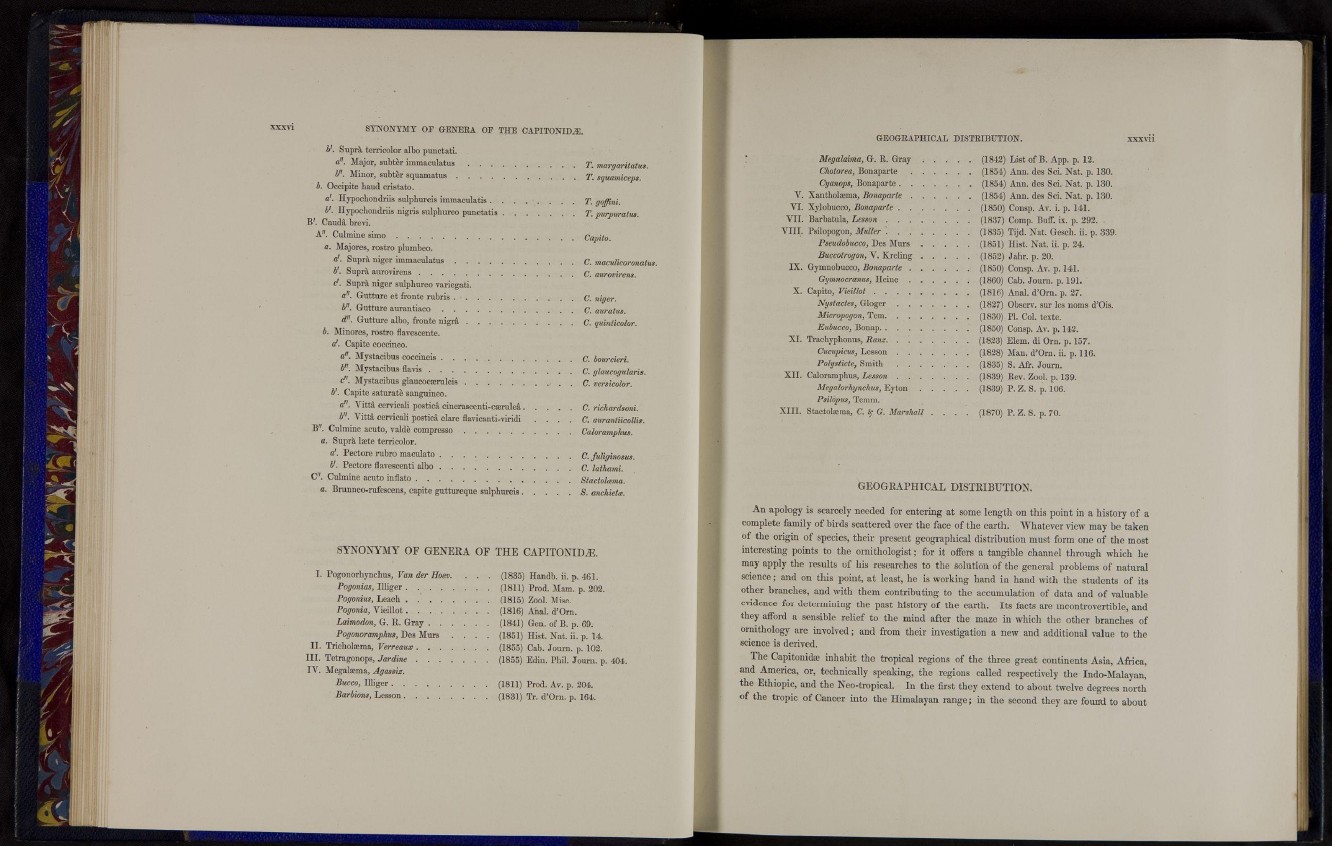
xxxvi SYNONYMY OP GENERA OF THE CAPITONIDiE.
V. Suprà tcrricolor albo punctati.
a". Major, subtèr immaculatus T. margaritatus.
b". Minor, subtèr squamatus T. squamiceps.
b. Occipite haud cristato.
cl. Hypochondriis sulphureis immaculatis . . . . . . . . T. goffini.
b'. Hypochondriis nigris sulplmreo punctatis T. purpuratus.
B'. Caudâ brevi.
A". Culmine simo Capito.
a. Majores, rostro plúmbeo.
a!. Suprà niger immaculatus C. maculicoronatus.
b'. Suprà aurovirens C- aurovirens.
ó. Suprà niger sulplmreo variegati.
a". Gutture et fronte rubris C. niger.
b". Gutture aurantiaco C*. auratus.
d". Gutture albo, fronte nigrâ C. quinticolor.
b. Minores, rostro flavescente.
a'. Capitc coccinco.
a". Mystacibus coccineis C. bourcieri.
b". Mystacibus flavis C. glaucogularis.
c". Mystacibus glaucocoeruleis / . . C. versicolor.
b'. Capite satúrate sanguíneo.
a". Vittíi cervicali posticâ cincrasccnti-caîruleâ C. richardsoni.
b". Vittâ cervicali posticâ clare flavicanti-viridi . . . . C. auranliicollis.
B". Culmine acuto, valdè compresso Caloramphus.
a. Suprà laite terricolor.
a'. Pectorc rubro maculato C. fuliginosus.
b'. Pcctore flavescenti albo C. lathami.
C". Culmine acuto inflato Stactolama.
a. Brunneo-rufescens, capite guttureque sulphureis S. anchietee.
S Y N O N Y M Y O F G E N E R A O F T H E C A P L T O N I M .
I. Pogonorhynchus, Van der Hocv. . . . (1835) Handb. ii. p. 4 6 1 .
Pogonias, Illiger (1811) Prod. Mam. p. 2 0 2 .
Pogonius, Leach (1815) Zool. Misc.
Pogonia, Vicillot (1816) Anal. d'Orn.
Laimodon, G. R. Gray (1841) Gen. o f B . p. 6 9 .
Pogonoramphus, Des Murs . . . . (1851) Hist. Nat. ii. p. 1 4 .
I I . Tricholarma, Verreaux (1855) Cab. Journ. p. 102.
I I I . Tctragonops, Jardine (1855) Edin. Phil. Journ. p. 404.
IV. Megalaima, Agassiz.
Bucco, Illiger (1811) Prod. Av. p. 204.
Barbions, Lesson (1831) Tr. d'Oni. p. 164.
GEOGRAPHICAL DISTRIBUTION. xxxvii
Megalaima, G. R. Gray (1842) List o f B . App. p. 1 2 .
Chotorea, Bonaparte (1854) Ann. des Sci. N a t . p. 130.
Cyanops, Bonaparte (1854) Ann. des S c i . Nat. p. 130.
V. Xantholrcma, Bonaparte (1854) Ann. des Sci. N a t . p. 130.
VI. Xylobucco, Bonaparte (1850) Consp. Av. i. p. 141.
V I I . Barbatula, Lesson (1837) Comp. Buff. ix. p. 2 9 2 .
V I I I . Psilopogon, Mailer '. (1835) Tijd. Nat. Gesch. ii. p. 3 3 9 .
Pseudobucco, Des Murs (1851) Hist. Nat. ii. p. 2 4 .
Buccotrogon, V. Kreling (1852) Jahr. p. 2 0 .
IX. Gymnobucco, Bonaparte (1850) Consp. Av. p . 141.
Gymnocranus, Heine (1860) Cab. Journ. p. 191.
X. Capito, Vieillot (1816) Anal. d'Orn. p. 2 7 .
Nystactes, Gloger (1827) Observ. sur l e s noms d'Ois.
Micropogon, Tcm (1830) Pl. Col. texte.
Eubucco, Bonap (1850) Consp. Av. p. 112.
XI. Trachyphonus, Ranz. . '. (1823) Elem. di Ora. p. 157.
Cuciipicus, Lesson (1828) Man. d'Orn. ii. p. 116.
Polysticte, Smith (1835) S. Afr. Journ.
X I I . Caloramphus, Lesson (1839) Rev. Zool. p. 139.
Megalorhynchus, Eyton (1839) P. Z. S. p. 106.
Psi/opus, Temm.
X I I I . Stactolrcma, C. # G. Marshall . . . . (1870) P. Z. S. p. 70.
GEOGRAPHICAL DISTRIBUTION.
An apology is scarcely needed for entering at some length on t h i s point in a history of a
complete family of birds scattered over the face of t h e earth. Whatever view may be taken
of the origin of species, their present geographical distribution must form one of the most
interesting points to the ornithologist; for it offers a tangible channel through which he
may apply the results of his researches to the solution of t h e general problems of natural
science; and on this point, at least, he is working hand in hand with the students of its
other branches, and with them contributing to the accumulation of data and of valuable
evidence for determining the past history of the earth. Its facts are incontrovertible, and
they afford a sensible relief to the mind after the maze in which the other branches of
ornithology are involved; and from their investigation a new and additional value to the
science is derived.
The Capitonida? inhabit the tropical regions of the three great continents Asia, Africa,
and America, or, technically speaking, the regions called respectively the Indo-Malayan,
t h e Ethiopic, and t h e Neo-tropical. In the first they extend to about twelve degrees north
of the tropic of Cancer into the Himalayan range; in the second they are found to about